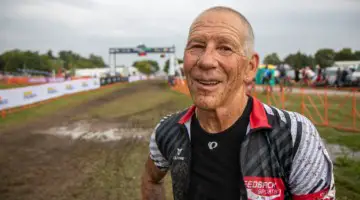With cyclocross season fast approaching, we want to help you get ready with our #crossiscoming series. We asked several top cyclocross coaches their thoughts on pre-cyclocross-season training for Part I of our latest Ask the Coaches. Stay tuned for Part II coming soon.
For those of us who get jazzed about cyclocross season every fall, but find it sneaks up on us every summer, there is always the risk of jumping into intense intervals or perhaps running too hard and too soon. Although the cyclocross season is short, it can still be a grind that requires planning and effective training to remain on good form through state championships and Nationals in December and Worlds in January for the top pros.
Here are three expert yet varied opinions on how to get ready for cyclocross season. Part I of our Q and A focuses on taking a break, running and volume/intensity. In part II, we will focus more on developing skills and body maintenance during the cyclocross season.
Our coaches for this Ask the Coaches are:
Brandon Davis. Brandon is the owner of Wattage Cottage Coaching in Wilmington, North Carolina. For the past several years, Brandon worked as a mechanic for the Aspire Racing team, which we spoke to him about earlier this year. Brandon has also contributed his coaching and mechanical expertise in the past.
Chris Mayhew. Coach Chris Mayhew likely needs no introduction for Cyclocross Magazine readers. The JBV Coaching coach has contributed Training Tuesday pieces for the past few years and has also written pieces addressing technical issues as well.
Joe Maloney. Joe is a new contributor to Cyclocross Magazine. Joe lives in Pullman, Washington, where he runs his coaching business JM Coaching. We have seen him before on ’cross podiums at the Chicago Cross Cup, and he also has a series of training videos available online.
Ask the Coaches: Pre-Cyclocross-Season Training, Part I
Cyclocross Magazine: There seems to be agreement a break in June/July is good for cyclocrossers. How long should it be? When should it be?
Brandon Davis: It’s more typical to have it in June, and I have it structured usually as an “optional week” meaning ride if you want to but don’t feel obligated. Question the “why” if you do ride because some athletes will give the excuse, “I don’t want to lose anything.” We are seeing a shift in that thought process though and more people are seeing the value in a break.
Chris Mayhew: How long should it be, and how long will it be, tend to be two different questions. The only things my clients complain about are Tabatas and ’cross break. I typically ask for 7-10 days, including a weekend. That’s to prevent “Hey, I took Monday to Thursday off, can I do a century this weekend as part of my break?” (That’s a real email)
I ask for 7-10 days and then negotiations begin. The more you’ve been riding the longer the break. I want you rested and motivated to begin what’s going to be a very hard, intense block of training. Whatever it takes to get you there is what I’d like.
Joe Maloney: The need for a break often comes from athletes having two disciplines. Time and duration of that break would be dependent on how seriously the athlete is focusing on ’cross and their other discipline. A really common timing is to take one to two weeks after Road or Mountain Nationals. But if the athlete isn’t racing either and focusing only on cyclocross, early July is better, and ideally, two to four weeks with other activities to stay in shape like hiking, some unstructured riding, swimming, anything they enjoy. That’s also a great time to supplement their strength training from the winter or take even more time to do a more complete strength training block of six to eight weeks.
CXM: How long is too long for a break?
CM: I suppose a month? Three weeks? I’ve not had a client where “too much” is an issue. And, if you look at pros who have had long periods off the bike in the summer (broken bones, typically) they have a really good fall. That was my experience, personally. Specifically, five weeks off the bike, with a bit of running. I had good results, a ton of fun and zero burnout by the end of the year. I would always rather have an athlete who’s a little under-trained than a razor’s edge fit one who really can’t care about turning the pedals again.
JM: Anything longer than four weeks with no training and you will start to lose significant fitness.
BD: Anything over 10 days, I’d say. Many performance physiologists agree that you will recover and grow stronger from training over 10-14 days before you start any loss in fitness gained. So to be on safe side, 10 days max.
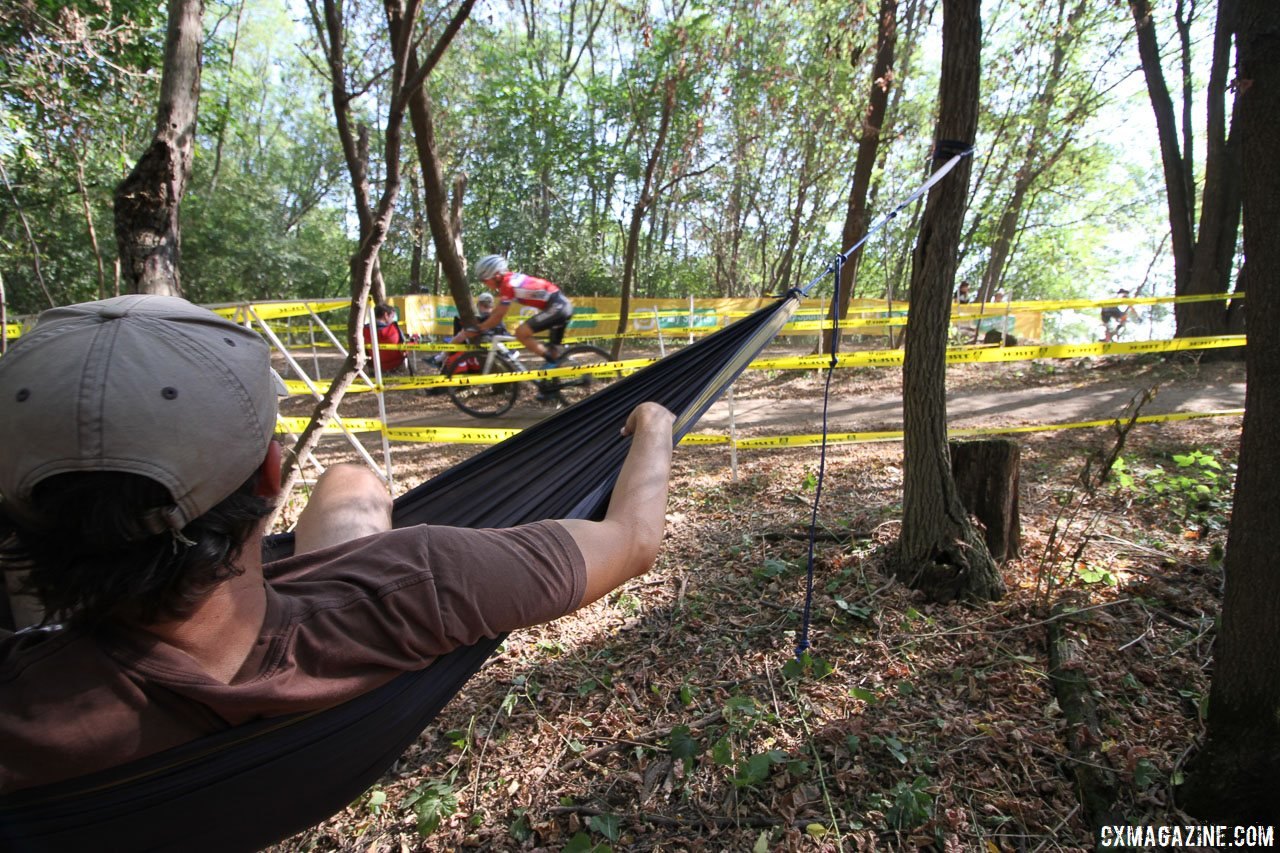
A pre-cyclocross-season break is good, but don’t take too much time off the bike. 2017 World Cup Waterloo Legends Race. © D. Mable / Cyclocross Magazine
CXM: If you are going to add running to your training, when should you start if you haven’t already?
JM: Running is a lot like cycling in that you need some base fitness before you get specific for cyclocross. Incorporating one longer run a week all summer long is ideal. But if you haven’t started yet start now with a relatively short 10 to 15-minute run period. Then bump it up to 20, 25 or 30 minutes. Usually post-mid-summer break is a good time to do more than one run a week., with a maximum of two longer runs early in the season.
BD: If the athlete doesn’t fight me on running then year round is fine. If they do I’ll start after June break.
CM: I would add running as soon as being a bit sore is not going to matter. If you have an important stage race in August I don’t want to compromise that. But once your big goals are behind you, a little bit of work would be good.
And I do mean a little bit. August and September races really don’t have that much running in them. The courses are so dry and hot it’s hard to force any real running in them.
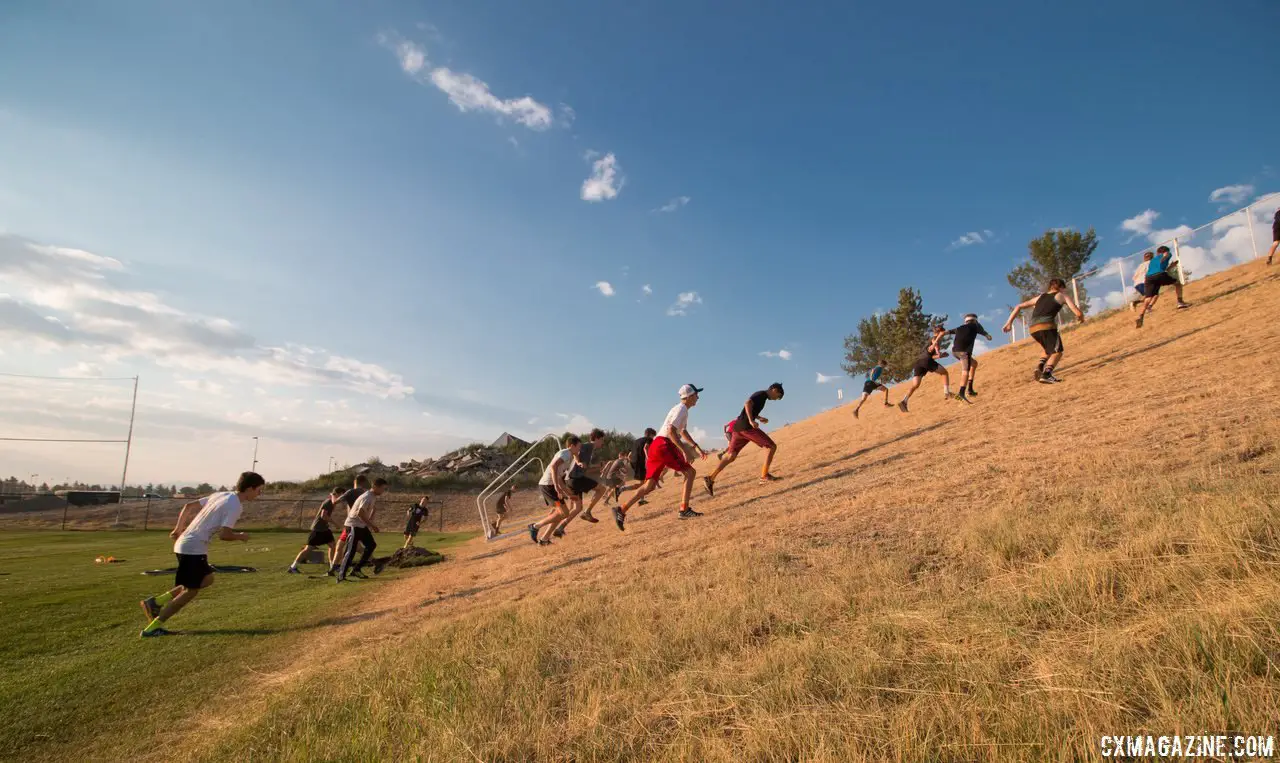
Adding some running to your training now can help get you ready when the weather turns bad. 2017 Montana Cross Camp © Cyclocross Magazine
CXM: How many times a week do you recommend working on running? Running in cyclocross is quite explosive, not just a jog. Is this what ’crossers should focus on, or should athletes start jogging first to get the body adjusted?
BD: On average, two times a week just as a run. Start small, one to two miles, and no need to go more than three to four. It depends on the person and how their form is and if they recover well from it. I recommend trail running over the road as trails get you moving laterally which all those cycling miles don’t do. It also works a lot of stabilizer muscles that don’t see a lot of work from cyclists.
CM: I don’t see the point in jogging and building up to say 30 minutes. That is a long run. And it’s 30 minutes of 9-minute miles with a bunch of heel striking (e.g. poor mechanics). And ultimately we’re not trying to be good runners, we’re trying to shore up a weakness in a very specific area of cyclocross.
Start small, really small. Say repeats of 50 meters. Uphill is great if you have it. Both the speed, short duration and elevation will all help enforce proper running mechanics. Do a few of those within a bike ride or ’cross practice. Add maybe 50 meters a week. You’ll find pretty soon you’re getting some good distances in that feel as easy as the shorter ones you started with.
And you don’t really need to run a lot, overall. A looooong run in ’cross would be 100m. How many laps would you do in a race like that? Eight maybe? If you can run a kilometer or two straight I think that’s about all you need for ’cross in terms of duration. Really it’s about running 10-50 meters pretty fast and being able to ride after that.
JM: With everything else going on, it’s difficult to get more than two, maybe three runs in a week at first. But once an athlete has adapted to running, one targeted run per week is enough in my opinion.
What’s best is to incorporate workouts that challenge your ability to transition and run explosively. What I mean by this is doing interval workouts on a grass field or gravel path that include some hard efforts. Dismount, do some hard explosive running and then remount and attack again. It’s really easy to focus on running and even doing specific running for cyclocross and still forget that in a lot of cases what really matters is a smooth dismount and remount.
Think about your typical cyclocross course. Break down the race by time spent riding, running, and dismounting/remounting. Often times the amount of time spent running is pretty similar to the amount of time dismounting and remounting. Workouts should reflect that.
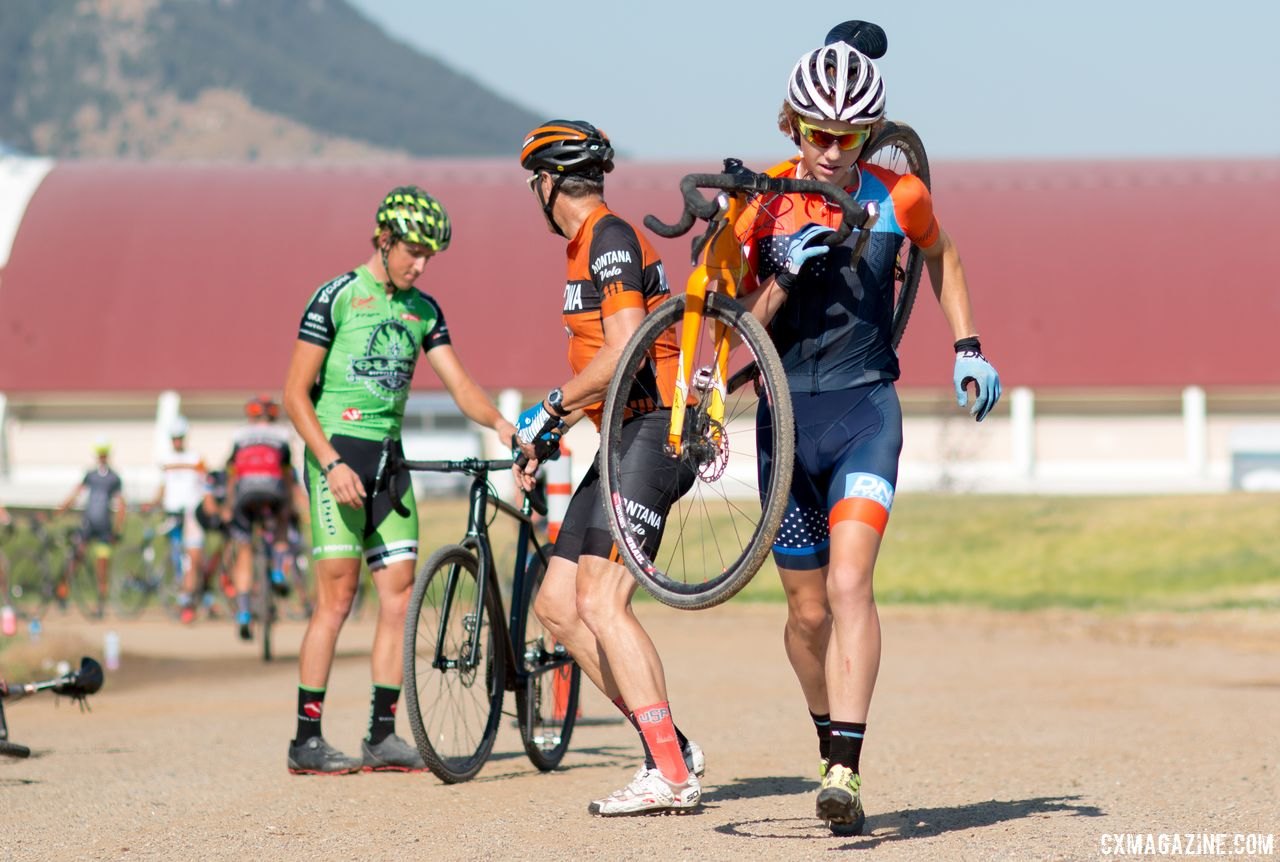
Kelton Williams practicing shoulder grabs and short runs at the 2017 Montana Cross Camp © Cyclocross Magazine
CXM: Intense intervals are usually part of cyclocross training. When is the sweet spot to start doing them?
CM: I’d say roughly eight weeks out from the start of your season. Maybe not the very first race of your season, but close. Six weeks is about as long as you can sustain really short intense intervals. You could go for longer but the results are diminishing and you may have hit your peak with them anyways. It’s hard to unburn popcorn, ya know? Then a week or two for a taper and off to the races!
JM: Intense intervals take six to eight weeks to start to have some effect. So for some, you might start six to eight weeks before your first race. However, for most that’s a little too early. The season is long and a lot of people burn out on intervals after 12 weeks or less.
I find that starting with less intense intervals (such as more traditional steady start intervals) to build the engine 8-12 weeks before the season starts and then switching to the very intense, race preparation or race simulation work one to four weeks before the first race allows athletes the variety to keep the workouts interesting and fun, without risking burnout as much.
BD: It depends on the athlete and how they respond. The really intense stuff of one minute or less most people respond quickly to, so I’ll sprinkle that in late July through August. But three to five-minute work, we will start integrating as soon as May or earlier if they race summer crits or XC. It’s really case dependent.
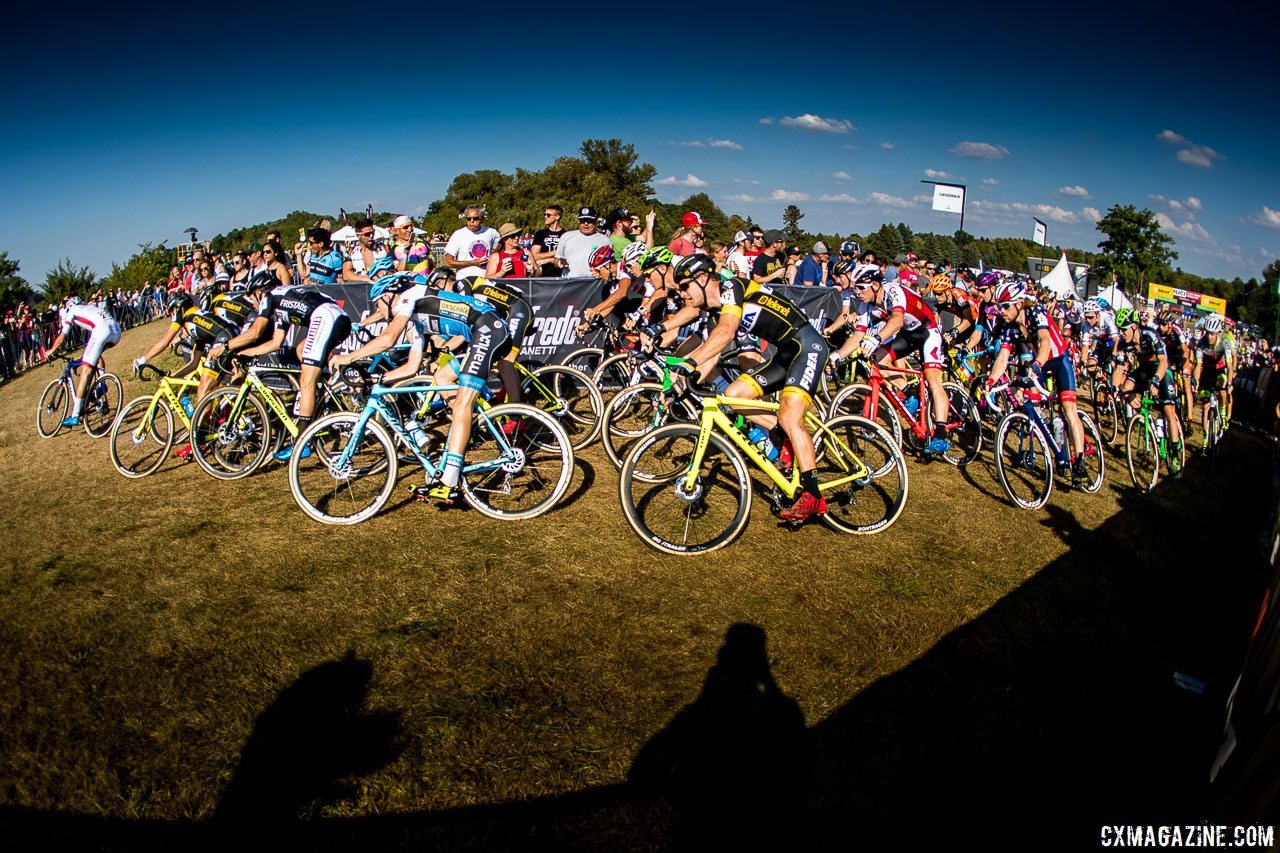
Short, intense intervals can help prepare you for the short bursts of acceleration cyclocross requires. 2017 World Cup Waterloo © J. Curtes / Cyclocross Magazine
CXM: Are there benefits for cyclocross of doing long endurance rides from early August on?
JM: For me, racing as primarily as a mountain biker, cyclocross season was always a slow, gradual loss of aerobic fitness. The races and specific workouts are so intense that you have to take time to rest and that makes it difficult to add endurance riding. But, it’s critical for a successful season because it enables you to do the harder, more intense workouts successfully.
For this reason, it’s a great idea to get out for those longer rides, but often that means taking a weekend off from racing or using a few of your race weekends for training. You can even add some longer rides after you’re done racing for the day if you’re really hardcore.
I have my athletes take at least one or two weekends off from racing even if they have the time to race so they can fit in some endurance rides to keep the fitness up. Or we’ll limit the weekend to a single race on Saturday and then make Sunday the long day in the saddle. It doesn’t need to be every weekend but aim for three to six longer days on the bike between your first race and the end of the season.
BD: Yes, those type of rides build mitochondrial density. Think fuel. Mitochondria carry oxygen for exercise… More oxygen, more fuel… More fuel, more results.
CM: I think so. Those get reframed closer to ’cross, but yes. When you’re only doing say an hour per day during the week, “long” might move to two to three hours. But it’s still long compared to what you have been doing.
And hopefully, the focus changes a bit too. Hit something other than pavement, work on some skills, etc. Intensity and duration are the primary ways to think about training. You’re getting all the intensity you can handle leading up to, and into, ’cross. Sometimes duration is a good way to come at fitness from another angle.
CXM: What are some common mistakes you see athletes make with their late-Summer / pre-cyclocross season training?
BD: Not enough race-specific intensity and not acknowledging the basics in training like starts and dismount/remount.
CM: Primarily I see people go straight from summer to ’cross without a break. Or have no plan for what to do when their summer fitness craters in October. People tend to race ’cross till they get burned out and that’s ugly. Have a plan and be proactive about managing your season rather than getting forced off the bike.
JM: A very common mistake is getting too excited too early and doing too hard of workouts, taking things too seriously too soon or expecting results early season.
The other mistake is not cleaning your bike. Wash your bike, lube your chain, replace your parts when they need it. You might spend all season slaving away doing your intervals and only gain five to eight percent in fitness or performance. The difference between a clean and a very dirty bike can be five percent or more in efficiency. Think about that, a whole season’s worth of training in a single bike wash!
Stay tuned for Part II of our preseason Ask the Coaches. If you find any of the information or approaches above to be helpful and are looking for a coach, don’t be afraid to reach out to any of the contributors.


























